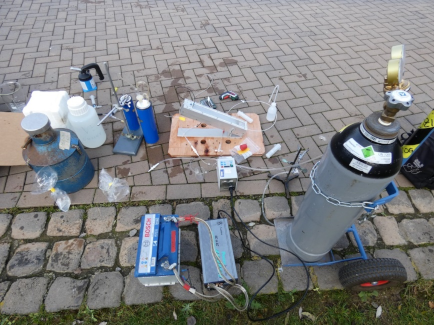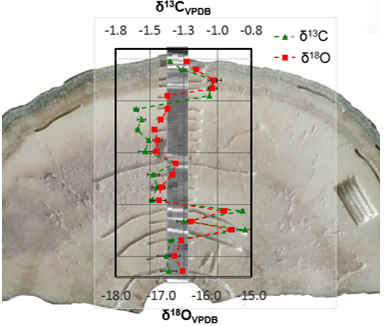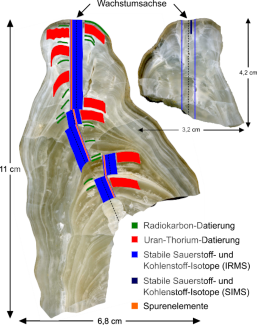Scientific background: Isotopic signatures of H, C, N, O and S provide important information about source and fate of the respective element in the geological and specific environmental processes. For example, they allow reconstructing paleoclimate conditions, fluid source and temporal changes, kinetic reaction processes and reaction pathways. We have analytical tools to investigate traditional stable isotope systems (S, C, N or H, O) in sulfides, sulfates, carbonates, TOC and water. We are continuously developing innovative methods for new applications or improve the application of relatively new / underexplored isotopic systems.
Our strength and some analytical challenges
- Characterizing isotopic signatures (C, O, clumped isotopes) in layered samples (speleothems, scalings) with high spatial resolution using micromill and IRMS
- Separation of elements from the sample matrix to enable precise and accurate isotopic measurements.
- Removing inorganic carbon from soil or sediment for δ13Corg measurements without washing out small dissolved organic molecules.
- Automated sampling and long-term storage of cave dripwater without alteration of the isotopic composition.
- Characterization of isotopic signatures on dust samples as source indicator.
- Studies of geothermal CO2 for determining the depth of effervescence
Analytical possibilities
Current research topics and projects
- Separating selenate from other oxyanions as prerequisite to use its oxygen isotopic signature as a source and process indicator.
- Validating established methods for inorganic carbon removal as sample preparation technique for δ13Corg measurements.
- Reconstruction of extreme paleoclimatic events in southern Germany or northern Vietnam based on carbonate isotopic signatures in stalagmites or flowstones (CheckExtrema, KaWaTec Solutions)
- Investigating geothermal water circulation using fluid inclusions in scales and travertines
- Studies of paleo-hydrological changes based on speleothems
- Laboratory and field assessment of isotopic signatures in geothermal CO2
Selected publications
- Kalb, M., Kluge, T., Eckardt, H., Weise, A., Prokhorov, I., Kraml, M., Eiche, E., Neumann, T. 2020. CO2,gas-H2Oliquid isotope exchange rates up to 150°C – experimental study and application to hydrothermal CO2. Geochimica et Cosmochimica Acta. doi.org/10.1016/j.gca.2019.10.023
- Hartmann, A., Luetscher, M., Wachter, R., Holz, P., Eiche, E., Neumann, T. 2018. Technical note: GUARD – an automated fluid sampler preventing sample alteration by contamination, evaporation and gas exchange, suitable for remote areas and harsh conditions. Hydrol. Earth Syst. Sci., 22, 4281–4293.
- Banning, H. 2017. Selenium Isotope Studies in Plants - Development and Validation of a Novel Geochemical Tool and its Application to Organic Samples. KIT Scientific Publishing, Karlsruhe. ISBN 9783731505945. https://www.ksp.kit.edu/9783731505945
- Tang, X.,Berner, Z.,Nalcaci, O.O., Norra, S. 2015. Selective separation and preconcentration of arsenite from arsenic enriched natural waters with three different adsorbents. Separation Science and Technology 50, 2112-2123.
- Schleicher, N., Yu, Y., Cen, K., Chen, Y., Chai, F., Wang, S., Norra, S. 2013. Source identification and seasonal variations of carbonaceous aerosols in the megacity Beijing – a stable isotope approach. In: Rauch, S., Morrison, G., Norra, S., Schleicher, N. (eds.): Urban Environment, 263-270, Springer.



